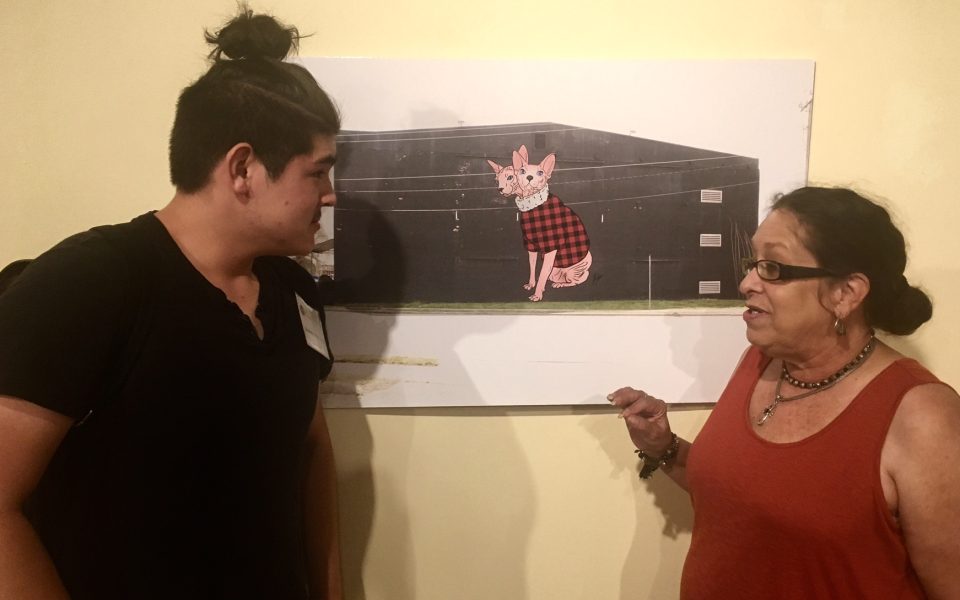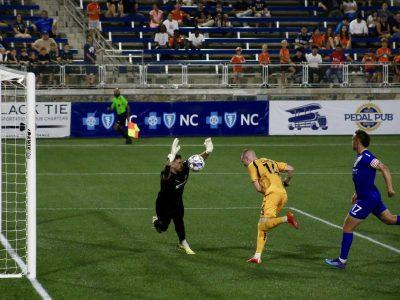First place-winner Brian Lewis’ rendering of a yawning dog ambling about town in lace-up shoes might be the most tongue-in-cheek statement about High Point of the night.
On June 1 — years after local artists began to form grassroots artists’ alliances —Theatre Art Galleries held an opening reception for Urban Expressions, an exhibit that reimagines public spaces in High Point. The gallery identified blank facades around High Point, snapped digital photos and invited local artists to Photoshop their mural ideas on those sites — 34 mural designs from 21 artists, any of which could be commissioned.
What feels like a watershed moment for community-supported efforts to rejuvenate the city’s urban spaces excites Brian Davis, an artist who moved to High Point from Lexington more than a decade ago.
“If I’m going to live in a place,” he said. “I’m gonna contribute, and this is what I’ve got to contribute.”
Davis benefited from artist Tammy McDowell’s and the Southwest Renewal Foundation’s support.
“I think it jumped off when I painted the tree frog on the French Interiors building,” he said. “That was in response to a time three or four years ago when an urban planner [Andres Duany] was brought into the city to assess what he thought we could do as far as establishing a stronger identity here. In the spirit of that, I presented the [frog] mural…. Now I really have a vision for where it can go and I think I’ve captured enough of the heart of the people around that their influence has helped me to really fit in.”
The 512 Collective, a teaching studio and gallery on Washington Street, is a vibrant hub for artists in High Point. McDowell played a part in reclaiming a crack house in the historic neighborhood, previously the center of black commerce during the first half of the 20th Century.
Throughout the opening reception, attendees fixated on a design by the collective’s incoming intern, Brandon “Milky” Owen: a two-headed hairless cat donning a red plaid sweater on a matte black background. Other imagined murals ranged from clever oddities to colorful and optimistic visions of High Point’s future.
Davis hopes that reestablishing High Point’s reputation as a cultural center will encourage more businesses to invest in the city.
“I hope one day to have tourism industry based solely on public art: murals, sculptures, interactive art, landscape design and everything in that arena,” Davis said. “We’ve been talking about that for years and are making steps in that direction.”
[pullquote]
Urban Expressions is open at the Theater Art Galleries at 220 E. Commerce Ave. (HP) through Aug. 4. Visit tagart.org for more information.
[/pullquote]
Davis said the idea is also practical.
“It’s probably the easiest thing you can do to change an atmosphere, to put a coat of paint on something,” he said. “The impact is far-reaching. One [mural] spawns another and — all of a sudden — you’ve got this groundswell of pride in your area where you want to do and see more and it takes on a personality of its own and grows organically.”
Some may regard Expressions as the natural culmination of a years-long movement to reclaim and beautify neglected spaces in High Point, but few in the arts community — McDowell least of all — expected this day to come. It seems the tide is turning, though; McDowell said that city council, wealthy donors and other community members are finally taking notice of undervalued local artists, and that positive community feedback after years of work is deeply rewarding.
“It fills my heart,” said McDowell. “It means we’ve made our mark in our hometown [and] I’m incredibly proud of all that we’ve accomplished. The next step for us is national: We’re fixin’ to get national recognition with a mural that Brian [Davis] and I designed for Washington Street as part of the project.”
McDowell and other artists remain primarily focused on serving long-ignored neighborhoods in High Point.
“To me, ‘no trespassing’ just means ‘don’t get caught,” she said. “Once we finish up the two or three houses in our neighborhood, we want to go across the street. The neighborhoods across from [the 512 Collective], there’s three or four city blocks with apartments that’ve been boarded-up and abandoned for 40, 50 years. So [the artists are] gonna paint them at their own expense. We realize it’s not permanent but for the time being, they’re a beautiful thing.”
Join the First Amendment Society, a membership that goes directly to funding TCB‘s newsroom.
We believe that reporting can save the world.
The TCB First Amendment Society recognizes the vital role of a free, unfettered press with a bundling of local experiences designed to build community, and unique engagements with our newsroom that will help you understand, and shape, local journalism’s critical role in uplifting the people in our cities.
All revenue goes directly into the newsroom as reporters’ salaries and freelance commissions.





Leave a Reply